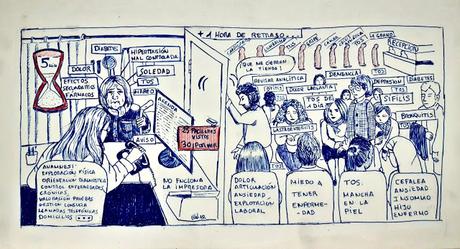
La máxima preocupación de nuestros gestores sanitarios en estos momentos tiene que ver con la vacunación y con volver a la normalidad. Lo primero nos va a tener ocupados a los centros de salud durante meses, añadido a la sobrecarga de tareas de diagnóstico, tratamiento, burocracia y seguimiento epidemiológico del coronavirus. Lo segundo se me antoja completamente imposible dado que el nivel de la Atención Primaria anterior a la pandemia era subnormal.
Partimos de una situación de muchos años de deconstrucción sanitaria lenta, suave y progresiva. Un desmantelamiento elegante que no ha usado piqueta ni ha levantado a penas polvo. Algo más bien invisible como no poner un suplente aquí, crear cinco huecos de agenda más allá, forzar un poquito acá, repartir otro poco acullá... y en ese plan. Nadie se ha atrevido a hacer una evaluación de los Equipos de Atención Primaria para ver cuántos siguen vivos, en qué numero se sigue trabajando en equipo y se ejerce una medicina familiar y comunitaria en condiciones. Puedo aventurar que una mayoría han devenido en hordas, perdonen la palabra, grupos desordenados donde cada cual va un poco a lo suyo y la consigna principal es sobrevivir. Y ahora sí elijo con precisión el sustantivo porque me consta que muchos dedican la mayor parte de su energía, creatividad y capacidad de innovación a salir vivos de cada jornada laboral.
Por todo esto causa desazón y vértigo tratar de aventurar cómo será la Atención Primaria post covid dado el erial en que se ha convertido la institución y dado el estado lamentable de los profesionales que salimos agotados de una travesía del desierto que nos ha dejado el alma flaca y exhausta.
Habrá que facilitar de nuevo la accesibilidad pero con su correspondiente ajuste. Si se abre de nuevo el grifo al máximo ni el sistema ni los profesionales aguantarán la presión dada la fragilidad de las cañerías. Esto significa dar un par de vueltas a la palabra FORZAR, un verbo del que se ha abusado y que ha hecho muchísimo daño a los profesionales de primaria, creo que mayormente a los facultativos. Creo que va siendo necesario salir del armario y denunciar el maltrato y el forzamiento continuo. Es hora de decir NO es NO.
El talón de Aquiles de la sanidad sigue siendo el aumento de las necesidades de salud de la población, por edad y patología pero también por disminución del umbral de tolerancia a la incomodidad. La demanda de servicios sanitarios tiende pues a infinito, mientras que la oferta pública es menguante. En este escenario o se modula el acceso o el sistema se funde.
¿Pero cómo cuadrar el círculo? Los economistas de la salud les ofrecerán largos discursos, los resumiré en cuatro puntos.
1. Estableciendo un ajustador económico, un copago.
2. Creando rebosaderos, servicios de “urgencia”.
3. Incentivando a los profesionales para que “doblen turno”o asuman más carga de trabajo.
4. Estableciendo una lista de espera.
De inicio les diré que ninguna de estas medidas gusta al político, al que le interesa ofrecer pan y circo (barato) para conseguir votos. El gestor sanitario poco puede hacer si no se lo dice el político, así que mantiene las cosas como están pese a que el barco cada vez está mas hundido. Y los profesionales a su vez con el agua al cuello y perdida la esperanza.
La ciudadanía se da cuenta de poco. Es verdad que ven con cada vez peor cara a sus profesionales, que hay más barullo en las salas de espera y que a veces le citan para más tarde. Pero los centros de salud siguen estando limpios y arreglados y aparentemente todo marcha bien. La lista de pacientes de su facultativo es invisible para ellos, no saben que cada día además de atenderle a él, su doctora verá a otros 50 o 60 pacientes. Cada uno con varios motivos de consulta, desde peregrinos a graves. No saben que esa presión asistencial es el doble o el triple que en otros países de la zona. No saben que muchos de sus médicos no pueden más.
Terminaré tratando de responder como me gustaría ver la asistencia postcovid. Lo primero decir que el ajuste de agendas debería ser más flexible. Entiendo que no es sencillo estar cambiándolas constantemente pero dada la complejidad de las poblaciones, los equipos asistenciales y las circunstancias sociales y epidemiológicas parece necesario adaptar la agenda a las necesidades del momento. Probablemente será necesario mantener huecos de consulta telefónica y favorecer otros canales de comunicación como el correo electrónico, la mensajería electrónica o las notas de papel (sí, que el paciente pueda hacer llegar a su profesional una nota con un informe, una petición de medicación o una duda o necesidad). Probablemente será necesario retomar las labores de salud comunitaria para poder activar las potencialidades de cuidado de la comunidad y coordinarnos mejor con ella. Probablemente haya que crear un nuevo contrato de cuidados entre cada profesional y sus pacientes, explicando cómo usar correctamente los servicios y pidiendo su ayuda para que estos no se saturen. Probablemente haya que asumir una gestión compartida del paciente sin cita, con problema de salud no urgente, para que entre administrativos, enfermeras y médicas se le atienda cuando corresponda.
Cada equipo se tendrá que arreglar. No cuento con ayuda del nivel de gestión ni del nivel político. Visto el devenir de la pandemia y los apoyos que hemos recibido, las promesas incumplidas y demás, tengo claro que seguiremos ayunando. Mientras el cuerpo aguante. Pero dado que estamos en cuaresma, tiempo tradicional de abstinencias y privaciones, me veo inspirado para llegar en buenas condiciones a la Semana Santa, siempre que la pandemia no nos lleve por delante. Cuídense.

Getting back to normal
The main concern of our health managers at the moment has to do with vaccination and getting back to normality. The former will keep us at primary health centres busy for months, in addition to the overload of diagnosis, treatment, bureaucracy and epidemiological monitoring of the coronavirus. The latter seems to me to be completely impossible given that the level of primary care prior to the pandemic was sub-normal.
We are starting from a situation of many years of slow, gentle and progressive health deconstruction. An elegant dismantling that has used no pickaxe and has hardly raised any dust. Something rather invisible, like not putting a substitute here, creating five agenda gaps there, forcing a little bit here, distributing a little bit there... and in that plan. Nobody has dared to make an evaluation of the Primary Care Teams to see how many are still alive, how many are still working as a team and are practising family and community medicine in good conditions. I can venture to say that most of them have become hordes, pardon the word, disorderly groups where everyone goes their own way and the main slogan is to survive. And now I choose the noun with precision because I know that many of them devote most of their energy, creativity and capacity for innovation to getting out of each working day alive.
For all these reasons, it is dismaying and vertigo-inducing to try to predict what Primary Care will be like post-covid, given the wasteland that the institution has become and given the pitiful state of the professionals who have emerged exhausted from a desert journey that has left our souls thin and exhausted.
Accessibility will have to be facilitated again, but with a corresponding adjustment. If the tap is opened again to the maximum, neither the system nor the professionals will be able to withstand the pressure given the fragility of the pipes. This means giving a couple of twists to the word FORCE, a verb that has been abused and has done a great deal of harm to primary care professionals, mostly, I think, to doctors. I think it is necessary to come out of the wardrobe and denounce the continuous mistreatment and forcing. It is time to say NO is NO.
The Achilles heel of healthcare continues to be the increase in the health needs of the population, due to age and pathology, but also due to the decrease in the threshold of tolerance to discomfort. The demand for health services is therefore tending towards infinity, while the public supply is dwindling. In this scenario, either access is modulated or the system collapses.
But how to square the circle? Health economists will give you long speeches, but I will summarise them in four points.
1. Establishing an economic adjuster, a co-payment.
2. By creating overflows, "emergency" services.
3. Incentivising professionals to "double shift" or take on more workload.
4. Establishing a waiting list.
To begin with, I will tell you that none of these measures appeals to politicians, who are interested in offering bread and circuses (cheaply) to get votes. The health manager can do little if the politician does not say so, so he keeps things as they are despite the fact that the ship is sinking more and more. And the professionals, in turn, are in the doldrums and have lost hope.
The citizenry realises little. It is true that they are seeing their professionals with increasingly bad faces, that there is more noise in the waiting rooms and that sometimes they are being called back for later appointments. But the health centres are still clean and tidy and everything seems to be going well. Their doctor's patient list is invisible to them, they don't know that every day, in addition to seeing him, their spanish family doctor will see 50 or 60 other patients. Each one with various reasons for consultation, from essay ones to serious. They don't know that this pressure of care is double or triple that of other countries in the area. They do not know that many of their doctors can no longer cope.
I will end by trying to answer how I would like to see postcovida care. First of all, the adjustment of schedules should be more flexible. I understand that it is not easy to keep changing them constantly, but given the complexity of the populations, the care teams and the social and epidemiological circumstances, it seems necessary to adapt the agenda to the needs of the moment. It will probably be necessary to maintain telephone consultation slots and favour other channels of communication such as e-mail, electronic messaging or paper notes (yes, that the patient can send a note to their professional with a report, a request for medication or a doubt or need). It will probably be necessary to take up community health work again in order to activate the care potential of the community and to coordinate better with it. It will probably be necessary to create a new care contract between each professional and his or her patients, explaining how to use the services correctly and asking for a new contract of care.
It will probably be necessary to assume a shared management of the walk-in patient with a non-urgent health problem, so that between administrative, nursing and medical staff, the patient is attended to when appropriate.
Each team will have to make its own arrangements. I am not counting on help from the management level or from the political level. Given the course of the pandemic and the support we have received, the unfulfilled promises and so on, it is clear to me that we will continue to fast. As long as the body holds out. But given that we are in Lent, the traditional time of abstinence and deprivation, I feel inspired to get to Easter in good shape, provided that the pandemic does not take us by surprise. Take care.

恢復正常自動翻譯,對錯誤感到抱歉。目前,我們的衛生經理主要關心的是疫苗接種和恢復正常。前者將使我們在冠狀病毒的診斷,治療,官僚機構和流行病學監測工作量過多的情況下,使我們在初級保健中心忙碌幾個月。鑑於大流行前的初級保健水平不正常,在我看來,後者似乎是完全不可能的。我們從多年緩慢,溫和和逐步進行的健康解構開始。優雅的拆解方式,不使用鎬頭,幾乎沒有揚起灰塵。相當不可見的東西,例如不在此處放置替代品,在此處創建五個議程空白,在此處強加一點,在此處分配一點……在該計劃中。沒有人敢於對基層醫療團隊進行評估,以查看有多少人還活著,有多少人仍在團隊中工作,並且在良好的狀況下練習家庭和社區醫學。我可以冒險地說,他們中的大多數人已經成群結隊,請原諒這個詞,無序的團體,每個人都走自己的路,主要口號是生存。現在,我選擇精確的名詞是因為我知道他們中的許多人將大部分精力,創造力和創新能力奉獻給了每個工作日。由於所有這些原因,鑑於該機構已成為荒地,並且由於沙漠旅行而精疲力竭的專業人員的可憐狀態,試圖預測初級保健將在重生後的經歷中令人沮喪和眩暈。那使我們的靈魂變得無精打采。無障礙功能將不得不再次便利,但要進行相應的調整。如果水龍頭再次打開到最大,由於管道易碎,系統和專業人員都將無法承受壓力。這意味著給“ FORCE”一詞做一些改動,該詞已被濫用,對初級保健專業人員,尤其是對醫生來說,造成了很大的傷害。我認為有必要走出衣櫃,譴責持續的虐待和強迫。現在該說不。醫療保健的致命弱點仍然是人口的健康需求的增加,這是由於年齡和病理狀況的原因,也是由於人們對不適感的耐受性閾值的降低。因此,在公共供應減少的同時,對衛生服務的需求趨於無限。在這種情況下,要么訪問被調製,要么系統崩潰。但是如何使圓圈平方呢?衛生經濟學家將為您作長篇演講,但我將在四點進行總結。1.建立經濟調節器,共付額。2.通過創建溢出“緊急”服務。3.激發專業人士“雙重轉變”或承擔更多工作量。4.建立候補名單。首先,我將告訴您,這些措施都不吸引有興趣提供麵包和馬戲團(便宜地)獲得選票的政客。如果政客不這麼說,衛生經理將無能為力,因此儘管船舶沉沒的情況越來越多,他仍然保持現狀。反過來,專業人士則處於低迷狀態,並失去了希望。公民一點都沒有意識到。的確,他們看到自己的專業人士的面孔越來越糟,候診室裡的聲音越來越大,有時他們被叫來做以後的約會。但是醫療中心仍然乾淨整潔,一切似乎都進行得很好。他們的醫生的病人名單對他們來說是看不見的,他們不知道每天除了見他之外,他們的西班牙家庭醫生還會見50或60個其他病人。每個人都有不同的諮詢理由,從短文到嚴肅的問題。他們不知道這種護理壓力是該地區其他國家的兩倍或三倍。他們不知道他們的許多醫生再也無法應付了。最後,我將嘗試回答我希望如何獲得後covida護理。首先,時間表的調整應更加靈活。我知道要不斷改變他們並不容易,但是鑑於人口,護理團隊以及社會和流行病學情況的複雜性,似乎有必要使議程適應當前的需求。可能有必要保持電話諮詢時間,並支持其他溝通渠道,例如電子郵件,電子消息或紙質便箋(是的,患者可以將便箋連同報告,藥物治療請求或書面通知發送給專業人士。疑問或需要)。為了激活社區的護理潛力並與之更好地協調,可能有必要再次進行社區衛生工作。在每個專業人員及其患者之間可能需要創建新的護理合同,解釋如何正確使用服務並要求新的護理合同。可能需要對非緊急健康問題的接診患者進行共享管理,以便在管理人員,護理人員和醫務人員之間適當地照顧患者。每個團隊都必須做出自己的安排。我指望的不是管理階層或政治階層的幫助。考慮到大流行的過程和我們所獲得的支持,未兌現的承諾等,對我來說很明顯,我們將繼續禁食。只要身體伸出來。但是鑑於我們處於禁酒和匱乏的傳統時期四旬期,只要大流行不會使我們感到意外,我就會受到鼓舞地以良好的狀態參加複活節。小心。
